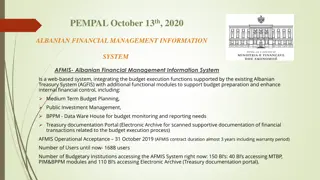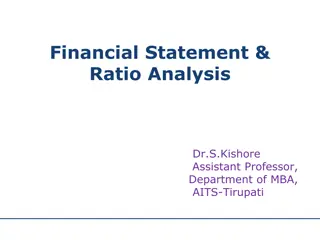Understanding the Financial System: A Comprehensive Overview
The financial system plays a vital role in any economy by facilitating the flow of funds between surplus and deficit units through financial markets and intermediaries. This system involves the mobilization of savings, investments, and credit allocation, ultimately supporting economic development. Learn about the key components and functions of the financial system in this insightful discussion.
Download Presentation

Please find below an Image/Link to download the presentation.
The content on the website is provided AS IS for your information and personal use only. It may not be sold, licensed, or shared on other websites without obtaining consent from the author. Download presentation by click this link. If you encounter any issues during the download, it is possible that the publisher has removed the file from their server.
E N D
Presentation Transcript
Introduction To Financial System
The economic development of any nation is reflected by the progress of the various economic units, broadly classified into corporate sector, government and household sector. The units in these sector are always placed in a surplus/deficit/balanced situation, which gives rise to the process of lending and borrowing. There are units or people with surplus funds and there are those with a deficit. Surplus units refers to those who have excess funds or excess income over expenditure and wants to invest. They are known as Savers or Investors. Deficit units refers to those having lack of funds and need to borrow. They have excess expenditure over income. They are known as Borrowers.
They share a mutual need of investing and borrowing by way of an financial transaction. The financial transaction is carried out at a common place known as Financial Market linked by Financial Intermediaries and thru the medium of Financial Instruments. The entire mechanism of mobilizing savings, investments and creating credit in an economy thru economic units for productive purpose is termed as Financial System. A financial system or financial sector functions as an intermediary and facilitates the flow of funds amongst the various units. People from the areas of surplus provide funds to the areas of deficit.
Finance + System = Financial System Finance means monetary resources comprising ownership funds and debts. System indicates a set of interrelated parts working together to achieve some purpose. Financial System refers to mobilizing surplus funds from people and organisations and to allocate them among deficit people and organisations. An investor is an example of a Surplus Unit whereas a borrower is an example of a Deficit unit.
Financial System Flow of Funds (Saving) Seekers of Funds (business firm & Govt) Suppliers of Funds (Households) Income & Financial Claims
Definitions The financial system is a set of institutional arrangements thru which financial surpluses available in the economy are mobilized. The financial system consists of a variety of institutions, markets and instruments related in a systematic manner provide the principal means by which savings are transformed into investments. A financial system is a set of systematically integrated constituents which enables smooth flow of finance from areas of surplus to areas of scarcity in such a way that risk is redistributed and economic development is accelerated.
Thus we can infer from the definitions that :- 1. The financial system is composed of several constituents. 2. All the constituents are related to each other. 3. These constituents come together in the system and mobilise savings. 4. Savings and the resultant investment leads to economic development.
Features of the Financial System It is a composition of various institutions, markets, regulations, laws, practices, transactions, claims and liabilities. It plays a vital role in the economic development of the country. It encourages both savings and investments. It links savers and investors. It helps in capital formation. It promotes efficient allocation of financial resources for socially desirable and economically productive purposes. It facilitates expansion of financial markets. It helps in creation of financial structure that lowers the cost of transactions. 1. 2. 3. 4. 5. 6. 7. 8.
1. Payment System Financial system helps for payment of goods and services. It provides a payment system for the exchange of goods and services. We find that majority of buyers and sellers of products or services prefer to pay and receive money thru banks to avoid the risk of carrying cash in large amount. (Banks, credit cards, debit cards etc.)
2. Link between savers and investors: One of the important function of financial system is to link the savers and investors and thereby help in mobilizing and allocating the savings effectively and efficiently. For ex : A person opening savings banks account or invests money in shares it means that they are using the financial system for channeling savings into the economy.
3. Pooling of Funds Modern business organisations require large investments which are often beyond the means of an individual or groups of individuals. Financial Markets and intermediaries which are an integral part of the financial system facilitates the pooling of household savings for financing business. Thus it enables households to participate in large enterprises. Small savings are pooled together and transformed into large amounts which promoters of business can avail to meet their financial needs.
4. Transformation of savings into Capital / Investment The savings are then channelized towards entities/persons who demand finance thru the medium of equity or debt. The money thus raised is used to expand operations, start new projects etc.
5. Reduces the cost of transaction and borrowing A financial system helps in creation of financial structure that lowers the cost of transactions. This has a beneficial influence on the rate of return to the savers. It also reduces the cost of borrowings. Thus the system generates an impulse among the people to save more.
6. Risk Management The financial system helps to reduce the risk of savers. Financial institutions like banks and mutual funds mobilise fund from the savers and lends them to borrowers and thereby bears the risk of borrowing. For ex : When a bank uses public deposits to lend to institutions, it is passing on the funds from savers to borrowers. However if a particular borrower does not repay the bank, the bank bears the loss and does not pass on that loss to the borrower thereby redistributing the risk.
7. Economic Development By transforming savings into capital and redistributing risk, the financial system enables smooth flow of funds to productive and scarce areas. This leads to higher production and increases employment and consumer demand, accordingly more goods are available and more people are willing to purchase them.
8. Provision of Liquidity The financial system provides a mechanism for an investor to sell securities whenever there is the need for cash.
Evolution of the Financial System
The Indian Financial System falls into 3 different phases : Pre Independence upto 1951 Post Independence 1951 - 1990 Post 1991
Pre Independence up to 1951 The structure of Indian Financial System during the Pre Independence Era was that of a traditional economy. The main features of the financial system pre 1951 was that of a closed economy consisting of : Semi organised Securities Market. Closed circle Industrial Entrepreneurship Restricted access to foreign savings Absence of financial institutions in long term industrial financing.
Post Independence upto 1990s During the post independence period there has been a significant growth in the Indian Financial System in terms of quantitative indicators as well as in diversification and innovations. This period was the progressive transfer of its important constituents from private ownership to public ownership. An overview of the development of the Indian Financial System in the post independence period up to 1990 s are as under : 1. Nationalisation of Banks & Insurance Sector. 2. Developmental Banks/Institutions. 3. Investor Protection
1. Nationalization of Banks & Insurance Sector The post 1951 phase was a landmark era in the history of Indian Financial System with the nationalisation of RBI and SBI. In 1969, 14 major commercial banks were brought under direct control of government of India. The nationalisation of LIC and GIC was yet another historical measure.
2. Development Banks / Institutions In addition to nationalization, the govt created a wide range of new institutions in the public sector. The institutions were created to cater to the financial needs of industries and between them cover the whole range of Industry. The public sector occupied a commanding position in the industrial financing system in India ex ; SIDBI, IFCI, IDBI, UTI etc.
3. Investors Protection During this period, there were gross mismanagement of companies, corporate frauds and abuses which results in loss of public confidence in corporate securities market. To restore investor faith and confidence, the government adopted drastic measures such as : The Companies Act, 1956 The Capital Issues Act, 1947 Securities Contracts Act, 1956 Monopolies & Restrictive Trade practices Act, 1970 Foreign Exchange Regulation Act, 1973
Post The New Industrial Policy 1991 The declaration of the New Industrial Policy witnessed a profound transformation in the Indian Financial System. The conservative philosophy of the development process in India shifted to free market economies. The notable developments in the Indian Financial System during this phase are :
1. From Public Control to Private Ownership The major steps initiated during this phase were to privatize important financial institutions. The conversion of the IFCI into a public limited company. IDBI offering their equity to private investors were all the part of privatization of financial institution. The setting up of private mutual funds and banks under the guidelines of RBI also came into existence.
2. Transformation of Institutional Structure The institutional structure of the Indian Financial System has undergone an outstanding transformation. It became more capital market oriented. This reflected in the changes in role, organizational policies, term lending, commercial banks, mutual funds and so on. In August 1991, a high level committee was appointed under the chairmanship of Mr. M. Narsimham (former RBI Governor) to examine all the aspects of the financial system.
The committee submitted its reports in November 1991. the notable reference made were : Privatization of Financial Institutions. Re-organisation of existing financial structure. Protection of Investors. Adequacy of Capital Structure. Review of Supervisory Arrangement. Improve Efficiency, Effectiveness and Competitiveness.
Weaknesses of Indian Financial System
1. Government Interference The Indian Financial System is all time politicised by excessive government intervention. The political intervention has its source in state ownership. This leads to virtual lack of freedom for the banks, financial institutions, financial markets etc. to enhance productivity and efficiency, greater degree of autonomy should be ensured.
2. Lack of Professionalism One of the drawback of Indian Financial System has been caused due to unprofessional management. Absence of work culture, inadequate internal controls, insufficient delegation of authority have caused competitive inefficiency. Professional attitude in management is very good for performance.
3. Lack of Direction The effectiveness of the financial system lies in rendering efficient and timely services. Limited delegation of authority, excessive regulation by govt and stringent controls have given rise to lack of direction in Indian Financial System.
4. Lack of Operational flexibility It is said that the functional autonomy is a pre requisite for operational flexibility of financial system to achieve improved performance in terms of productivity, efficiency and profitability. Due to tight regulation and strict controls by govt, there is lack of operational flexibility in Indian Financial System.
5. Excessive Regulation One of the issues in the Indian Financial System is that of over regulation. If every aspect of the system is subject to control and approval, then the financial system loses its innovative character which obstructs the growth. Though Indian Financial System has adopted liberal reforms since 1991, still there are scopes to adopt the same in other spheres.
6. Lack of Coordination There are large numbers of participants in the Indian Financial System. It is characterized pre dominantly by the public sector institution, which at times give rise to the problem of coordination in the working of these institutions.
7. Lack of Transparency The banks and financial institutions adopt certain accounting practices which do not show realistic picture. There is lack of transparency in such disclosures. It raises the problem of integrity with regard to the Indian Financial System and hampers the financial health of the economy. The banks make themselves more transparent and accountable in order to gain investor confidence.























